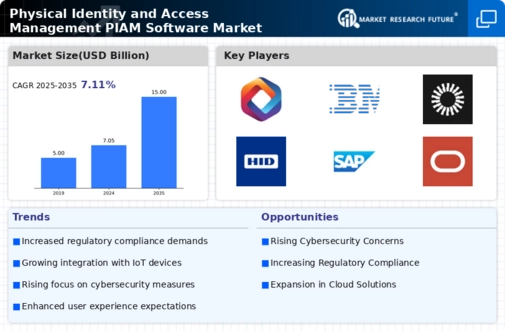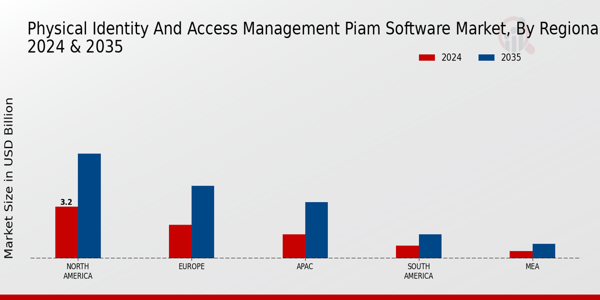Regulatory Compliance
Regulatory compliance remains a critical driver for the Global Physical Identity and Access Management PIAM Software Market Industry. Organizations are increasingly required to adhere to stringent regulations regarding data protection and access control. Compliance with frameworks such as GDPR and HIPAA necessitates robust identity management solutions. As a result, businesses are investing in PIAM software to ensure they meet these legal obligations while safeguarding sensitive information. This trend is likely to contribute to the market's expansion, as organizations recognize the importance of compliance in maintaining their reputation and avoiding potential penalties.
Market Growth Projections
The Global Physical Identity and Access Management PIAM Software Market Industry is poised for substantial growth, with projections indicating a market size of 7.05 USD Billion in 2024 and an anticipated increase to 15 USD Billion by 2035. This growth trajectory suggests a robust demand for PIAM solutions, driven by factors such as increasing security concerns, technological advancements, and regulatory compliance. The expected CAGR of 7.1% from 2025 to 2035 further underscores the market's potential, indicating a strong shift towards comprehensive identity and access management strategies across various sectors.
Technological Advancements
Rapid technological advancements are significantly influencing the Global Physical Identity and Access Management PIAM Software Market Industry. Innovations in biometric technologies, cloud computing, and artificial intelligence are enhancing the capabilities of PIAM solutions. These advancements facilitate more efficient identity verification and access control processes, thereby improving overall security. As organizations seek to leverage these technologies, the market is expected to grow substantially, with a projected CAGR of 7.1% from 2025 to 2035. This growth indicates a shift towards more integrated and automated systems that can adapt to the dynamic security landscape.
Increasing Security Concerns
The Global Physical Identity and Access Management PIAM Software Market Industry is driven by escalating security concerns across various sectors. Organizations are increasingly prioritizing the protection of sensitive information and physical assets. This heightened focus on security is evident in the projected market size of 7.05 USD Billion in 2024, reflecting a growing investment in advanced PIAM solutions. As threats evolve, businesses are compelled to adopt sophisticated access management systems to mitigate risks. This trend is particularly pronounced in industries such as finance and healthcare, where regulatory compliance and data protection are paramount.
Integration with Existing Systems
The integration of PIAM solutions with existing security infrastructure is a key factor propelling the Global Physical Identity and Access Management PIAM Software Market Industry. Organizations are seeking seamless interoperability between PIAM systems and other security technologies, such as video surveillance and alarm systems. This integration enhances overall security posture and operational efficiency. As businesses strive for a unified security approach, the demand for PIAM software that can easily integrate with legacy systems is expected to rise. This trend is indicative of a broader movement towards holistic security solutions that address multiple facets of organizational safety.
Growing Demand for Remote Access Solutions
The growing demand for remote access solutions is shaping the Global Physical Identity and Access Management PIAM Software Market Industry. As organizations adopt hybrid work models, the need for secure remote access to physical and digital resources has intensified. PIAM software that facilitates secure access for remote employees is becoming increasingly essential. This shift is reflected in the market's anticipated growth, with projections indicating a rise to 15 USD Billion by 2035. Organizations are recognizing the importance of maintaining security while enabling flexibility, thus driving investments in advanced PIAM solutions.
























